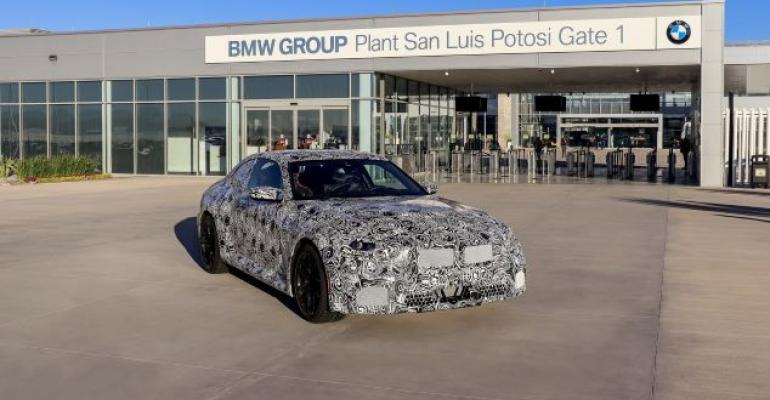MEXICO CITY – BMW’s plan to invest $865 million in boosting its electric-vehicle manufacturing capacity in Mexico suggests that capacity may be increasingly focused on the U.S. market.
The German automaker will spend this money over the next four years to enable production of the “Neue Klasse” EV range at its San Luis Potosi plant starting in 2027.
The Mexican plant currently produces three internal-combustion-engine models that are supplied to 74 markets worldwide, and the EV capacity also would be focused on overseas sales, says Harald Gottsche, president and CEO of BMW Group Plant San Luis Potosí.
“Our most important markets are Europe and the U.S. (and) due to the proximity (of San Luis Potosi) 60% (of production) goes to the U.S.,” he says. “So free trade is very important today and will be for our business model in the future.”
Matt Blunt, president of the American Automotive Policy Council, tells Wards this investment, part of $15 billion in investment announcements registered by the Mexican Automotive Assn. (AMIA) since 2021, is rooted in the U.S.-Mexico -Canada Agreement (USMCA) trade deal and tax credits granted by the U.S. Inflation Reduction Act (IRA).
“The fact that we have the USMCA is just indicative of the fact that we have a cohesive North American marketplace and production platform, and I think that reflects in Canada and Mexico being specifically cited in the Inflation Reduction Act as qualifying countries” for sources of tax rebate-eligible EVs, Blunt (pictured, below left) says.
 BMW board member Milan Nedeljković says the trade pact and the IRA influenced the automaker’s EV expansion plans: “By 2025, we ought to have more than 2 million fully electric vehicles on the road. Before 2030, our aim is to have at least every second BMW (sold) being a fully electric vehicle. To achieve these ambitious targets, we are now investing in our production network worldwide.”
BMW board member Milan Nedeljković says the trade pact and the IRA influenced the automaker’s EV expansion plans: “By 2025, we ought to have more than 2 million fully electric vehicles on the road. Before 2030, our aim is to have at least every second BMW (sold) being a fully electric vehicle. To achieve these ambitious targets, we are now investing in our production network worldwide.”
The IRA requires that autos undergo final assembly in North America to qualify for the consumer tax credit. In addition, to access the full credit amount, a minimum 40% by value of an EV battery’s critical minerals must be extracted or processed in the U.S. or by a U.S. free-trade agreement partner. Blunt says that will prompt more USMCA-bloc investment.
The critical-minerals minimum percent value will increase at a rate of 10% per year. “The minerals should not come from China…This is one of the primary challenges for the industry in the short term,” Blunt says.
The Mexican government recently announced plans to mine one of those critical minerals, lithium, in the northern state of Sonora, which will be overseen by the recently created government agency LitioMX. However, this is considered a long-term plan that will not immediately add to or displace BMW’s contracts with other countries such as Argentina and Australia.
Nevertheless, the BMW investment includes $550 million for a new facility for the assembly of high-voltage batteries for EVs to be built at the automaker’s manufacturing complex in San Luis Potosí.
According to consultant Thomas Karig, a former vice president of corporate relations and compliance officer at Volkswagen, the battery assembly plant is “essential” for BMW, as it will also help its vehicles comply with a second requirement established by the IRA to access tax credits.
This establishes that to claim the $3,750 battery-components portion of the tax credit, a qualifying EV must contain a set percentage of those components manufactured in North America. The percentage currently is 50% and is expected to increase at a yearly rate of 10%.

Ford building battery-electric Mustang Mach-E CUV at Cuautitlán, Mexico.
Another requirement establishes that the price of the EVs should not exceed $80,000 for vans and trucks and $55,000 for other vehicles. Here is where BMW’s second reason to invest in Mexico lies, according Karig: “BMW is a premium brand, and there will be some models whose prices exceed those established in the Inflation Reduction Act. To export those and all of their cars to the U.S. with no customs tariffs, the vehicles need to meet the USMCA rules of origin requirements that include battery components.
“This is why the USMCA requirements are more important than the Inflation Reduction Act, which generated a lot of political noise,” he says.
BMW is not the only company that has recently announced investments in Mexico. Evergo, Cenntro Automotive, General Motors, Ford, Audi, Volkswagen, BRP, Nidec, Foxconn and CATL, among others, have made EV investment announcements, which include vehicle production, parts manufacturing and charging station buildout.
“Nearly 40% of the total of plant relocation or nearshoring and investments in our country correspond to Chinese companies, 20% to U.S. companies, 11% Japanese ones, 9% German companies and 8% (South) Korean ones,” Alberto Bustamante, director of the Mexican automotive parts industry association (INA), says, adding Mexico exported 87% of all vehicles produced domestically in January, a trend that is expected to continue.
“Mexico would naturally become an EV production harbor,” Karig observes. “It has been one of the main automotive investment destinations during the last 20 years – as the number of plants built during that period is only comparable to China’s, and EV and combustion-engine-related investments will continue to arrive in the country.”
Blunt agrees: “With the assembly requirements, the entire region will see more and more sourcing for electric-vehicle components from north America, which means loads of potential investments. The future is bright for the three (USMCA) countries.”





